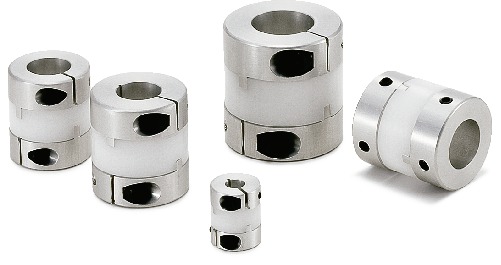MOR

Flexible coupling – Oldham – type – Set screw type
Dimension Drawing

Dimensions/Specifications/CAD
| Part Number | A | L | W | E | F | M | Wrench Torque (N・m) |
|---|---|---|---|---|---|---|---|
| MOR-6 | 6 | 2.5 | 8.4 | 2.1 | 1.3 | M2 | 0.3 |
| MOR-8 | 8 | 2.5 | 9.6 | 3.1 | 1.3 | M2 | 0.3 |
| MOR-10 | 10 | 2.9 | 10.2 | 4.1 | 1.4 | M2 | 0.3 |
| MOR-12 | 12 | 3.9 | 14.2 | 5.2 | 2 | M3 | 0.7 |
| MOR-15 | 15 | 4.4 | 16 | 8.2 | 2.2 | M3 | 0.7 |
| MOR-17 | 17 | 4.9 | 19.8 | 8.2 | 2.5 | M3 | 0.7 |
| MOR-20 | 20 | 5.8 | 21.4 | 12.2 | 2.9 | M4 | 1.7 |
| MOR-26 | 26 | 7.3 | 25.6 | 14.2 | 3.7 | M4 | 1.7 |
| MOR-30 | 30 | 10 | 32.5 | 16.2 | 5 | M4 | 1.7 |
| MOR-34 | 34 | 11.1 | 34 | 16.2 | 5.6 | M5 | 4 |
| MOR-38 | 38 | 12.1 | 40 | 20.3 | 6.1 | M5 | 4 |
| MOR-45 | 45 | 13.8 | 46 | 22.3 | 6.9 | M6 | 7 |
| MOR-55 | 55 | 18.7 | 57 | 26.5 | 9.4 | M8 | 15 |
| MOR-68 | 68 | 24 | 77 | 38.5 | 12 | M10 | 30 |
| Part Number | Max. Bore Diameter (mm) | Rated Torque* (N・m) | Max. Torque* (N・m) | Max. Rotational (min-1) | Static Torsional Stiffness (N・m/rad) | Max. Lateral Misalignment (mm) | Max. Angular Misalignment (°) | Mass** (g) |
|---|---|---|---|---|---|---|---|---|
| MOR-6 | 2 | 0.2 | 0.4 | 100000 | 5 | 0.5 | 3 | 0.4 |
| MOR-8 | 3 | 0.5 | 1 | 78000 | 12 | 0.7 | 3 | 0.8 |
| MOR-10 | 4 | 0.8 | 1.6 | 63000 | 23 | 0.9 | 3 | 1 |
| MOR-12 | 5 | 1 | 2 | 52000 | 60 | 1 | 3 | 3 |
| MOR-15 | 8 | 1.6 | 3.2 | 42000 | 80 | 1 | 3 | 4 |
| MOR-17 | 8 | 2.2 | 4.4 | 37000 | 120 | 1.2 | 3 | 7 |
| MOR-20 | 12 | 3.2 | 6.4 | 31000 | 120 | 1.2 | 3 | 9 |
| MOR-26 | 14 | 6 | 12 | 24000 | 300 | 1.5 | 3 | 20 |
| MOR-30 | 16 | 15 | 30 | 21000 | 530 | 2 | 3 | 38 |
| MOR-34 | 16 | 16 | 32 | 18000 | 1000 | 2.5 | 3 | 52 |
| MOR-38 | 20 | 28 | 56 | 16000 | 1500 | 2.5 | 3 | 69 |
| MOR-45 | 22 | 30 | 60 | 14000 | 2400 | 3 | 3 | 110 |
| MOR-55 | 26 | 45 | 90 | 11000 | 4100 | 4 | 3 | 230 |
| MOR-68 | 38 | 80 | 160 | 9000 | 6400 | 4.5 | 3 | 430 |
*Adjustment of rated and max. torque specifications for load fluctuations is not required.
However, if operating temperature exceeds 30℃, please adjust rated torque and max. torque as detailed in the table below.
The operational temperature range for MOS is -20℃ to 80℃. For more detailed information, please refer to Selection Guidelines [PDF 171KB].
**Based on the max. shaft bores.
| Part Number | Stock Bores D1-D2 | ||||||||||||||||||||||
|---|---|---|---|---|---|---|---|---|---|---|---|---|---|---|---|---|---|---|---|---|---|---|---|
| 1 | 1.5 | 2 | 3 | 4 | 5 | 6 | 6.35 | 8 | 9.525 | 10 | 12 | 14 | 15 | 16 | 18 | 20 | 22 | 25 | 28 | 30 | 35 | 38 | |
| MOR-6 | ● | ● | ● | – | – | – | – | – | – | – | – | – | – | – | – | – | – | – | – | – | – | – | – |
| MOR-8 | ● | – | ● | ● | – | – | – | – | – | – | – | – | – | – | – | – | – | – | – | – | – | – | – |
| MOR-10 | – | – | ● | ● | ● | – | – | – | – | – | – | – | – | – | – | – | – | – | – | – | – | – | – |
| MOR-12 | – | – | – | ● | ● | ● | – | – | – | – | – | – | – | – | – | – | – | – | – | – | – | – | – |
| MOR-15 | – | – | – | – | ● | ● | ● | ● | ● | – | – | – | – | – | – | – | – | – | – | – | – | – | – |
| MOR-17 | – | – | – | – | ● | ● | ● | ● | ● | – | – | – | – | – | – | – | – | – | – | – | – | – | – |
| MOR-20 | – | – | – | – | ● | ● | ● | ● | ● | ● | ● | ● | – | – | – | – | – | – | – | – | – | – | – |
| MOR-26 | – | – | – | – | – | ● | ● | ● | ● | ● | ● | ● | ● | – | – | – | – | – | – | – | – | – | – |
| MOR-30 | – | – | – | – | – | – | – | – | ● | ● | ● | ● | ● | ● | ● | – | – | – | – | – | – | – | – |
| MOR-34 | – | – | – | – | – | – | – | – | – | – | ● | ● | ● | ● | ● | – | – | – | – | – | – | – | – |
| MOR-38 | – | – | – | – | – | – | – | – | – | – | ● | ● | ● | ● | ● | ● | ● | – | – | – | – | – | – |
| MOR-45 | – | – | – | – | – | – | – | – | – | – | ● | ● | ● | ● | ● | ● | ● | ● | – | – | – | – | – |
| MOR-55 | – | – | – | – | – | – | – | – | – | – | – | – | ● | ● | ● | ● | ● | ● | ● | – | – | – | – |
| MOR-68 | – | – | – | – | – | – | – | – | – | – | – | – | – | – | – | ● | ● | ● | ● | ● | ● | ● | ● |
●All products come with set screws (MOS) or cap screws (MOS-C).
●Tolerance of shaft bore on MOS-8 is H8.
●Recommended tolerance for shaft diameters is h6 and h7.
●Bore and keyway modifications are available on request. Please take advantage of our bore modification services.
For more information please refer to Custom Bore Modifications [PDF 495KB].
Material/Finish
| MOR/MOR-C/MOR-K/MOR-CK | |
|---|---|
| Hub | A2017 Alumite Treatment |
| Spacer | Polyacetal |
| Hex Socket Set Screw | SCM435 Ferrosoferric oxide film |
| Hex Socket Head Cap Screw | SCM435 Ferrosoferric oxide film |
Structure
Set Screw type

Clamping type

Set Screw + Key type

Clamping + Key type

Characteristics
- Applicable motors
MOR Servomotor – Stepping Motor ○ General-purpose motor ◎ ◎: Excellent ○: Very good
- Property
MOR High torque ◎ Allowable Misalignment ◎ Small eccentric reaction force ◎ Electrical insulation ◎ Allowable operating temperature -20℃ to 80℃ ◎: Excellent ○: Very good
- This is an oldham-type flexible coupling.
- Slippage of hubs and a spacer allows large eccentricity and angular misalignment to be accepted.
- The eccentric reaction force generated by misalignment is small and the burden on the shaft is reduced.
- The simple structure allows the unit to be easily assembled.
Application
Sputtering device / Parts feeder / Industrial sewing machine /
Amusement device
Selection
The area bounded by the shaft diameter and rated torque indicates is the selection size.


Selection example
In case of selected parameters of shaft diameter of φ 6 and load torque of 0.3 N•m, the selected size is MOR-15.
Ambient Temperature / Temperature Correction Factor
| Ambient temperature | Temperature correction factor |
|---|---|
| -20℃ to 30℃ | 1.00 |
| 30℃ to 40℃ | 0.80 |
| 40℃ to 60℃ | 0.70 |
| 60℃ to 80℃ | 0.55 |
Comparison of rated torque

Spacer’s projection structure
Spacer’s projection structure allows large angular to be effortlessly accepted. It reduces burden on the shaft.

In the oldham-type coupling whose spacer has no projection, the spacer and hubs interfere with each other near outside diameter, so that the max. angular misalignment is small (1° – 1.5°) and that the bending moment arises on the shaft.
NBK’s oldham type coupling allows the angular misalignment to be easily accepted since the projection serves as support. Bending moment does not arise. Therefore, the max. angular misalignment is large (3°) and the burden on the shaft is reduced.
Slip Torque
Concerning the sizes shown in the following table, please note that the shaft’s slip torque is smaller than the max. torque of MOR-C.
| Part Number | Bore diameter | ||||||||||||||||||
|---|---|---|---|---|---|---|---|---|---|---|---|---|---|---|---|---|---|---|---|
| 3 | 4 | 5 | 6 | 6.35 | 8 | 9.525 | 10 | 12 | 14 | 15 | 16 | 18 | 20 | 22 | 25 | 28 | 30 | 35 | |
| MOR-12C | 0.8 | 1.9 | 2.4 | ||||||||||||||||
| MOR-15C | 2.3 | 3.5 | 4.8 | ||||||||||||||||
| MOR-17C | 2.7 | 3.6 | 4 | ||||||||||||||||
| MOR-20C | 3.7 | 4.2 | 4.3 | 5.7 | 6.1 | ||||||||||||||
| MOR-26C | 4 | 6.4 | 9.3 | 11.8 | |||||||||||||||
| MOR-30C | 7.5 | 13.6 | 13.9 | 17.2 | 20.4 | ||||||||||||||
| MOR-34C | 16.5 | 18.6 | 23.3 | 30.9 | |||||||||||||||
| MOR-38C | 19.4 | 20.2 | 24 | 30 | 34.1 | 37.8 | 38.8 | ||||||||||||
| MOR-45C | 34.5 | 41.8 | 42.6 | 44.5 | 48.4 | ||||||||||||||
| MOR-55C | 73.2 | 75.9 | 88.1 | ||||||||||||||||
| MOR-68C | 101.5 | 104.3 | 104.9 | 105.4 | 110.5 | 115.4 | |||||||||||||
These are test values based on the condition of shaft’s dimensional allowance: h7, hardness: 34 – 40 HRC, and screw tightening torque of the values described in MOR-C Dimension table.
Change in static torsional stiffness due to temperature
This is a value under the condition where the static torsional stiffness at 20°C is 100%.
The change of torsional stiffness within the range of allowable operating temperature is as shown in the graph.
Before using the unit, be aware of the deterioration of responsiveness.

Eccentric Reaction Force
These are initial slippage load values of hubs and a spacer.
After running-in operation, the slippage load becomes small, the load on the shaft due to misalignment becomes lowered, and the burden on the shaft bearing is reduced.








